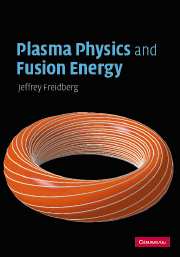Book contents
- Frontmatter
- Contents
- Preface
- Acknowledgements
- Units
- Part I Fusion power
- 1 Fusion and world energy
- 2 The fusion reaction
- 3 Fusion power generation
- 4 Power balance in a fusion reactor
- 5 Design of a simple magnetic fusion reactor
- Part II The plasma physics of fusion energy
- Appendix A Analytical derivation of 〈ς v〉
- Appendix B Radiation from an accelerating charge
- Appendix C Derivation of Boozer coordinates
- Appendix D Poynting's theorem
- Index
- References
3 - Fusion power generation
Published online by Cambridge University Press: 14 May 2010
- Frontmatter
- Contents
- Preface
- Acknowledgements
- Units
- Part I Fusion power
- 1 Fusion and world energy
- 2 The fusion reaction
- 3 Fusion power generation
- 4 Power balance in a fusion reactor
- 5 Design of a simple magnetic fusion reactor
- Part II The plasma physics of fusion energy
- Appendix A Analytical derivation of 〈ς v〉
- Appendix B Radiation from an accelerating charge
- Appendix C Derivation of Boozer coordinates
- Appendix D Poynting's theorem
- Index
- References
Summary
Introduction
The laws of physics have shown that a large amount of kinetic energy is released every time a nuclear fusion reaction occurs. Determining the conditions under which this energy can be converted into useful societal applications, such as the production of electricity or hydrogen, requires a substantial amount of analysis and is discussed in Chapters 3–5. The logic of the presentation, starting from the end goal and working backwards, is as follows. The desirability of fusion ultimately depends upon the design of practical, economical reactors that have a favorable power balance: Pout ≫ Pin. Two qualitatively different concepts have been proposed to achieve this goal, magnetic fusion and inertial fusion. This book focuses on magnetic fusion.
The end goal of Chapters 3–5 is to present a simple design for a magnetic fusion reactor. In order to develop the design, knowledge of the macroscopic power balance in a magnetic fusion system is required as input. Power balance is discussed in Chapter 4. As might be expected, this analysis involves a variety of physical phenomena representing various sources and sinks of power. Many of these phenomena will be familiar to readers, including thermal conduction, convection, and compression. However, the macroscopic power generated by nuclear fusion reactions, which is clearly the most crucial source term in the system, will probably be less familiar. Similarly, the radiation losses due to the Coulomb interactions between charged particles may also be less familiar.
- Type
- Chapter
- Information
- Plasma Physics and Fusion Energy , pp. 37 - 59Publisher: Cambridge University PressPrint publication year: 2007



